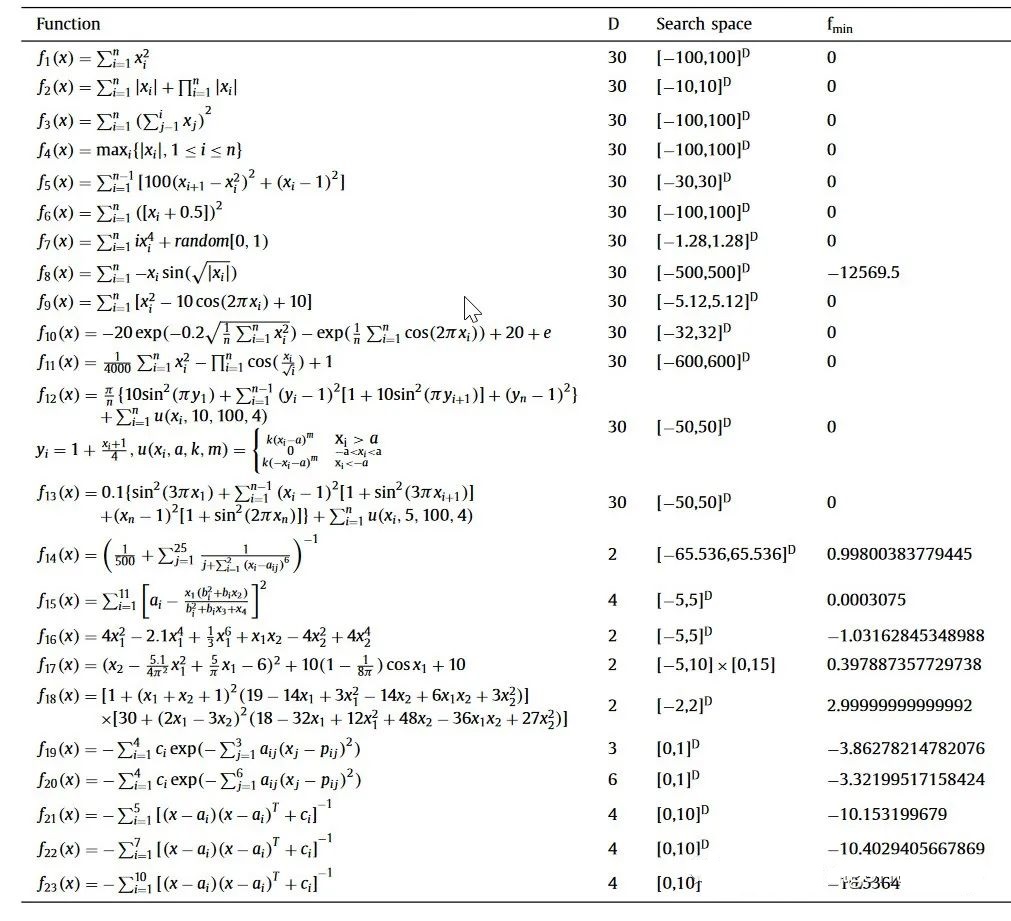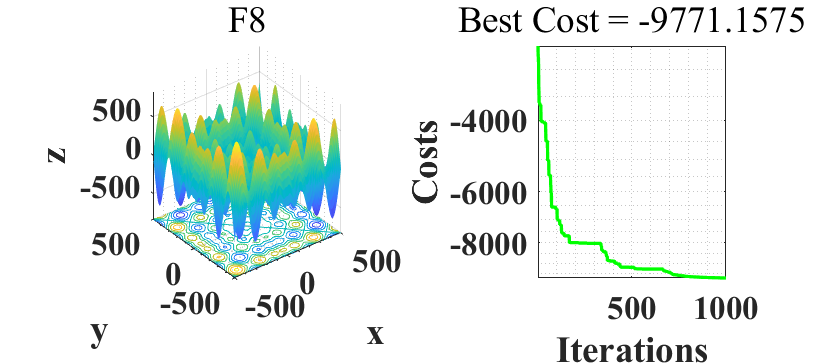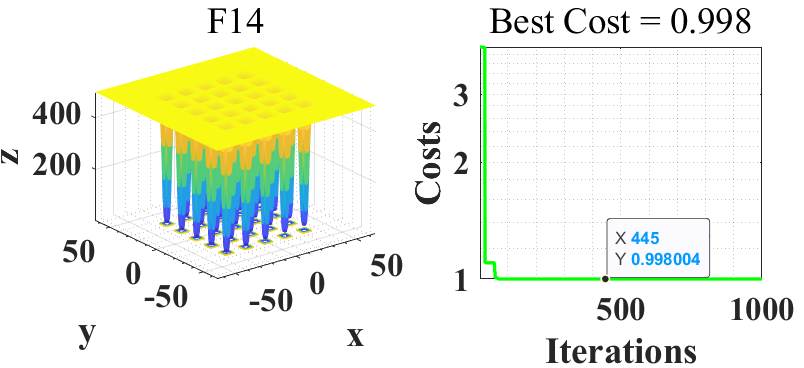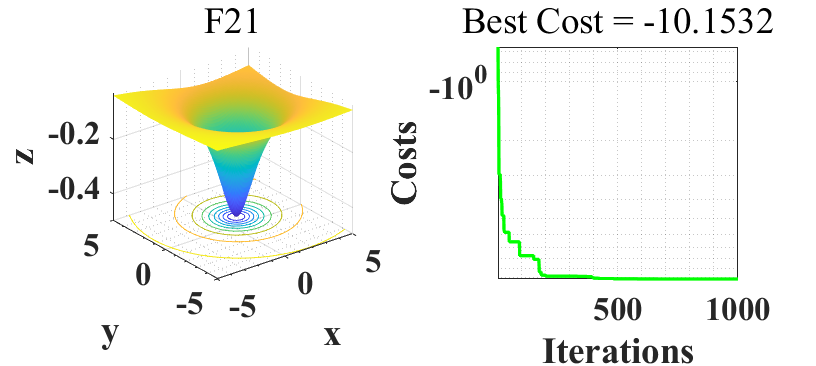今天给大家带来一个有意思的智能优化算法,IBL算法。
先说效果:在CEC2005函数集测试,基本上毫无压力,把把都能预测的很准确,而且速度极快。大家可以自行尝试哈。
为啥说这个算法有意思呢,大家看IBL的英文全称是:Incomprehensible but Intelligible-in-time logics,我在这里给大家直译成中文就是:难以理解但又能及时理解的逻辑。可能我翻译的不太准确啊,但是我又结合他的摘要,大概的理解就是:人类的思维不像计算机那样,人类的思维是可以随着时间、事物的变化而变化的,在之前看起来毫无逻辑的事情,在经过人类学习一段时间后,这个事情就会变得很有逻辑了。不得不说老外这个思维是真的奇特哈,根据这个也能提出一个新算法,而且效果还很不错。大家感兴趣的可以去看看原文。
参考文献:
Mirrashid, M.; Naderpour, H. Incomprehensible but Intelligible-in-time logics: Theory and optimization algorithm. Knowl.-Based Syst. 2023, 264, 110305. doi点击链接跳转原文
废话不多说,依旧是2005函数集的测试,附上2005函数集的理论范围:

大部分优化函数在F8上的表现是不太好的,也就寻优到-4000多,咱们试一下这个IBL:

WOW,直接就干到-9700多去了,看样子不错呀,回头了我会将2023年最新的算法做一个对比,决一雌雄一下。
再试一个F14的,理论值是1,能找到0.998004,还阔以

最后再来一个:

上核心代码!
function [Bests_Results,n_it_phase1,n_it_phase2,n_it_phase3,costs1,costs2,costs3] = ILA (CostFunction,Vmin,Vmax,nV,nNL,nModel,nIt,mIt_Phase1,mIt_Phase2,Bmin,Bmax,nRep,nIt_classification)%% Initialization
Empty.NL = []; % Current NL
Empty.NLprevious = []; % Previous NL
Empty.Cost = inf;
Empty1.NL = []; % Current NL
Empty1.Average = []; % Previous NL
Empty1.Cost = inf;
Empty1.Members = [];
Experts = repmat (Empty, nNL, 1); % Experts
n_it_phase1 = round(nIt*mIt_Phase1); % Number of iterations in phase 1
n_it_phase2 = round(nIt*mIt_Phase2); % Number of iterations in phase 2
n_it_phase3 = nIt-n_it_phase1-n_it_phase2; % Number of iterations in phase 3
costs1 = zeros(n_it_phase1,1); % Costs of the phase 1
costs2 = zeros(n_it_phase2,1); % Costs of the phase 2
costs3 = zeros(n_it_phase3,1); % Costs of the phase 3
n_Groups = zeros(nModel,1);
Em.NL = [];
Em1.NL = [];
Em1.Cost = inf;
Expert_IbI = repmat (Em1, 1, 1); % The best solution of the current generation
Logic = repmat (Em1, 1, 1); % The best solution before the current generation
Expert_new = repmat (Em1, 1, 1);
K0 = repmat (Em, nNL, 1); % Knowledge 0
K1 = repmat (Em, nNL, 1); % Knowledge 1
Expert_new.NL = [];
Expert_new.Cost = inf;
Knowledge_Phase1 = K0;
Knowledge_Phase2 = K0;
Knowledge_Phase3 = K0;
GroupNumber = ones(nNL,1);
Em2.NL = [];
Em2.Cost = inf;
Bests_Results = repmat (Em2, nIt, 1);if length(Vmin) ~= (nV)Vmin=Vmin.*ones(1,nV);Vmax=Vmax.*ones(1,nV);
endfor i = 1:nNLExperts(i).NL = unifrnd(Vmin,Vmax,1,nV);Experts(i).NLprevious = unifrnd(Vmin,Vmax,1,nV);Experts(i).Cost = CostFunction(Experts(i).NL);
end% Extract the Logic (Best NL in the previous solutions)
for i = 1:nNLif CostFunction(Experts(i).NLprevious) <= Logic.CostLogic.Cost = CostFunction(Experts(i).NLprevious); % The best solution of before the current generationLogic.NL = Experts(i).NLprevious;endif Experts(i).Cost <= Expert_IbI.CostExpert_IbI.Cost = Experts(i).Cost; % The best solution of the current generationExpert_IbI.NL = Experts(i).NL;end
endn_t = zeros(nModel,1);
nt = round((n_it_phase1)/nModel);
for m = 1:nModeln_t(m,1) = nt;
end
n_t(nModel,1) = (n_it_phase1)-(nModel-1)*nt;for m = 1:nModeln_Groups(m,1) = randi(round(nNL/2)); % Number of workgropus in each model
end%% Phase 0: Grouping (Clustering)for m = 1:nModel% ClusteringMAT = zeros(nNL,nV);for i = 1:nNLMAT(i,:) = Experts(i).NL;endopts = statset('MaxIter',nIt_classification);lastwarn('Success');GroupNumber0 = GroupNumber;GroupNumber = kmeans(MAT,n_Groups(m,1),'Distance','sqeuclidean','Replicates',nRep,'Options',opts);[warningMessage, warningMessageID] = lastwarn;if contains(warningMessage, 'Failed to converge')warnStruct = warning('off');GroupNumber = GroupNumber0;if m ==1n_Groups(m,1) = 1;elsen_Groups(m,1) = n_Groups(m-1,1);endendExperts_Groups = repmat (Empty1, n_Groups(m,1),1);n_members = zeros(n_Groups(m,1),1);for c = 1:n_Groups(m,1)nn=0;for i = 1:nNLif GroupNumber(i,1) == cnn = nn+1;endendn_members(c,1) = nn;Experts_Groups(c).Members = repmat (Em, n_members(c,1), 1);end%% Phase 1: Workgropusfor it_phase1 = 1:n_t(m,1)for c = 1:n_Groups(m,1)SUM = 0;num = 0;for i = 1:nNLif GroupNumber(i,1) == cnum = num+1;SUM = Experts(i).NL + SUM;Experts_Groups(c).Members(num).NL = Experts(i).NL;if Experts(i).Cost <= Experts_Groups(c).CostExperts_Groups(c).NL = Experts(i).NL;Experts_Groups(c).Cost = Experts(i).Cost;endendendExperts_Groups(c).Average = SUM./n_members(c,1);end% Calculate the ratiosD = zeros(nNL,1);P = zeros(nNL,1);C = zeros(nNL,1);for i = 1:nNLC(i,1) = sqrt(sum((Experts(i).NL-Logic.NL).^2));D(i,1) = sqrt(sum((Experts(i).NL-Experts(i).NLprevious).^2));P(i,1) = sqrt(sum((Experts(i).NL-Experts_Groups(GroupNumber(i,1)).NL).^2));endmin_D = min(D); max_D = max(D);min_P = min(P); max_P = max(P);min_C = min(C); max_C = max(C);Rc = (C-min_C)./(max_C-min_C);Rp = (P-min_P)./(max_P-min_P);RD = (D-min_D)./(max_D-min_D);Bc = Bmin + (Bmax-Bmin)*rand();Bp = Bmin + (Bmax-Bmin)*rand();BD = Bmin + (Bmax-Bmin)*rand();for i = 1:nNLB = Bmin + (Bmax-Bmin)*rand();if (Rc(i,1) <= Bc) && (Rp(i,1) <= Bp)random_member = randi (n_members(GroupNumber(i,1),1));K0(i).NL = Rp(i,1).*(Experts(i).NL + Experts_Groups(GroupNumber(i,1)).Members(random_member).NL)./2;elseif (Rc(i,1) <= Bc) && (Rp(i,1) > Bp)K0(i).NL = Rp(i,1).*(Experts(i).NL + Experts_Groups(GroupNumber(i,1)).Average)./2;elseif (Rc(i,1) > Bc) && (Rp(i,1) <= Bp)random_member = randi (n_members(GroupNumber(i,1),1));K0(i).NL = Rp(i,1).*(Experts_Groups(GroupNumber(i,1)).NL + Experts_Groups(GroupNumber(i,1)).Members(random_member).NL)./2;elseif (Rc(i,1) > Bc) && (Rp(i,1) > Bp)K0(i).NL = Rp(i,1).*(Experts_Groups(GroupNumber(i,1)).NL + Experts_Groups(GroupNumber(i,1)).Average)./2;endif RD(i,1)<= BDK1(i).NL = (rand()).*(Experts_Groups(GroupNumber(i,1)).Average);elseK1(i).NL = (rand()).*(unifrnd(Vmin,Vmax,1,nV));endKnowledge_Phase1(i).NL = abs(K0(i).NL + K1(i).NL)./2;% Update the NLalpha1 = -1.5+3.*rand(1,nV);Expert_new.NL = Experts(i).NL + alpha1.*(Knowledge_Phase1(i).NL);Expert_new.NL = max(Expert_new.NL, Vmin);Expert_new.NL = min(Expert_new.NL, Vmax);E1 = Experts(i).NL;Expert_new.Cost = CostFunction(Expert_new.NL);COEF = -1.5+3*rand();K = rand().*Experts_Groups(GroupNumber(i,1)).NL;NEW.NL = COEF.*(Expert_new.NL) + K;NEW.NL = max(NEW.NL, Vmin);NEW.NL = min(NEW.NL, Vmax);NEW.Cost = CostFunction(NEW.NL);if NEW.Cost < Expert_new.CostExpert_new = NEW;endif Expert_new.Cost < Experts(i).CostExperts(i).NL = Expert_new.NL;Experts(i).Cost = Expert_new.Cost;endif Experts(i).NL ~= E1Experts(i).NLprevious = E1;endE1 = Expert_IbI.NL;if Experts(i).Cost < Expert_IbI.CostExpert_IbI.Cost = Experts(i).Cost;Expert_IbI.NL = Experts(i).NL;endif Expert_IbI.NL ~= E1Logic.NL = E1;endendcosts1((m-1)*(n_t(1,1))+it_phase1,1) = Expert_IbI.Cost;Bests_Results((m-1)*(n_t(1,1))+it_phase1).NL = Expert_IbI.NL;Bests_Results((m-1)*(n_t(1,1))+it_phase1).Cost = Expert_IbI.Cost;end
end
NUM = n_it_phase1;
for it_phase2 = 1:n_it_phase2
NUM = NUM+1; % Calculate the ratiosfor i = 1:nNLC(i,1) = sqrt(sum((Experts(i).NL-Logic.NL).^2));D(i,1) = sqrt(sum((Experts(i).NL-Experts(i).NLprevious).^2));P(i,1) = sqrt(sum((Experts(i).NL-Expert_IbI.NL).^2));endmin_D = min(D); max_D = max(D);min_P = min(P); max_P = max(P);min_C = min(C); max_C = max(C);Rc = (C-min_C)./(max_C-min_C);Rp = (P-min_P)./(max_P-min_P);RD = (D-min_D)./(max_D-min_D);Bc = Bmin + (Bmax-Bmin)*rand();Bp = Bmin + (Bmax-Bmin)*rand();BD = Bmin + (Bmax-Bmin)*rand();for i = 1:nNLB = Bmin + (Bmax-Bmin)*rand();if (Rc(i,1) <= Bc) && (Rp(i,1) <= Bp)random_member = randi (nNL);K0(i).NL = Rp(i,1).*(Experts(i).NL + Experts(random_member).NL)./2;elseif (Rc(i,1) <= Bc) && (Rp(i,1) > Bp)SUM = 0;for ii = 1:nNLSUM = Experts(ii).NL + SUM;endAverage = SUM./nNL;K0(i).NL = Rp(i,1).*(Experts(i).NL + Average)./2;elseif (Rc(i,1) > Bc) && (Rp(i,1) <= Bp)random_member = randi (nNL);K0(i).NL = Rp(i,1).*(Expert_IbI.NL + Experts(random_member).NL)./2;elseif (Rc(i,1) > Bc) && (Rp(i,1) > Bp)SUM = 0;for ii = 1:nNLSUM = Experts(ii).NL + SUM;endAverage = SUM./nNL;K0(i).NL = Rp(i,1).*(Expert_IbI.NL + Average)./2;endif RD(i,1)<= BDSUM = 0;for ii = 1:nNLSUM = Experts(ii).NL + SUM;endAverage = SUM./nNL;K1(i).NL = (rand()).*(Average);elseK1(i).NL = (rand()).*(unifrnd(Vmin,Vmax,1,nV));end% Update the NLKnowledge_Phase2(i).NL = abs(K0(i).NL + K1(i).NL)./2;alpha2 = -0.75+1.5.*rand(1,nV);Expert_new.NL = Experts(i).NL + alpha2.*(Knowledge_Phase2(i).NL);Expert_new.NL = max(Expert_new.NL, Vmin);Expert_new.NL = min(Expert_new.NL, Vmax);E1 = Experts(i).NL;Expert_new.Cost = CostFunction(Expert_new.NL);COEF = -0.75+1.5*rand();K = rand().*(Expert_IbI.NL);NEW.NL = COEF.*(Expert_new.NL) + K;NEW.NL = max(NEW.NL, Vmin);NEW.NL = min(NEW.NL, Vmax);NEW.Cost = CostFunction(NEW.NL);if NEW.Cost < Expert_new.CostExpert_new = NEW;endif Expert_new.Cost < Experts(i).CostExperts(i).NL = Expert_new.NL;Experts(i).Cost = Expert_new.Cost;endif Experts(i).NL ~= E1Experts(i).NLprevious = E1;endE1 = Expert_IbI.NL;if Experts(i).Cost < Expert_IbI.CostExpert_IbI.Cost = Experts(i).Cost;Expert_IbI.NL = Experts(i).NL;endif Expert_IbI.NL ~= E1Logic.NL = E1;endendcosts2(it_phase2,1) = Expert_IbI.Cost;Bests_Results(NUM).NL = Expert_IbI.NL;Bests_Results(NUM).Cost = Expert_IbI.Cost;
end%% Phase 3: IbI Logic Searchfor it_phase3 = 1:n_it_phase3
NUM = NUM+1; for i = 1:nNLSUM = 0;for ii = 1:nNLSUM = SUM + Experts(ii).NL;endAverage = SUM./nNL;factor = randi(2);if factor == 1Knowledge_Phase3(i).NL = abs(Average - Experts(randi(nNL)).NL);elseKnowledge_Phase3(i).NL = abs(Average - Expert_IbI.NL);endalpha3 = -0.25+0.5.*rand(1,nV);Expert_new.NL = Experts(i).NL + alpha3.*(Knowledge_Phase3(i).NL);Expert_new.NL = max(Expert_new.NL, Vmin);Expert_new.NL = min(Expert_new.NL, Vmax);Expert_new.Cost = CostFunction(Expert_new.NL);COEF = -0.25+0.5*rand();K = rand().*(Expert_IbI.NL);NEW.NL = COEF.*(Expert_new.NL) + K;NEW.NL = max(NEW.NL, Vmin);NEW.NL = min(NEW.NL, Vmax);NEW.Cost = CostFunction(NEW.NL);if NEW.Cost < Expert_new.CostExpert_new = NEW;endif Expert_new.Cost < Experts(i).CostExperts(i).NL = Expert_new.NL;Experts(i).Cost = Expert_new.Cost;endif Experts(i).Cost < Expert_IbI.CostExpert_IbI.Cost = Experts(i).Cost;Expert_IbI.NL = Experts(i).NL;endendcosts3(it_phase3,1) = Expert_IbI.Cost;Bests_Results(NUM).NL = Expert_IbI.NL;Bests_Results(NUM).Cost = Expert_IbI.Cost;
end%% Extract the results
Expert_IbI.Cost = CostFunction(Expert_IbI.NL);end下方小卡片回复关键词:2023,免费获取2023年智能优化算法合集matlab代码。
后续会继续发布2023年其他最新优化算法,敬请关注。
本文链接:https://my.lmcjl.com/post/2921.html

4 评论